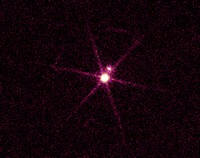|
       
> Star Formation
> Life and Death of a star
> Physical Description
> Star Catalogues
> Classification of Stellar Spectra
> Double Stars
> Variable Stars
> Neutron Star
> Black Holes
    
|
More than half of the
stars in the sky are actually members of two-star (binary) systems or
multiple-star systems. Some nearby double stars appear separate when
viewed telescopically, but many more are detected as doubles only by
spectroscopic means. A double-star system consists of two stars that are
physically close to each other and that revolve in an orbit around their
common centre of mass. Such double stars were first recognized by the
British astronomer William Herschel in 1803.
 |
Sirius A & B
A double star system in the constellation
Canis Major The Chandra X-ray image of Sirius A & B, a double star
system located 8.6 light years from Earth, shows a bright source and
a dim source. The central bright source is Sirius B, a dense white
dwarf star with a surface temperature of about 25,000 degrees
Celsius. The dim source (slightly above and to the right of Sirius
B) is Sirius A, a normal star more than twice as massive as the Sun.
The spoke-like pattern of light is an instrument artifact due to the
transmission grating. |
Spectroscopic binaries, first identified in 1889, are not visually
separable by the telescope but can nevertheless be recognized by means of
doubling or broadening of the spectrum lines as the star pair revolves.
When one component moves away from the Earth the other approaches it; the
spectrum lines from the receding star shift towards the red, while those
from the advancing star shift towards the violet.
Another type of double star is the so-called eclipsing variable. Stars of
this type are composed of a brighter and a darker component. As seen from
the Earth, when the orbit is such that the fainter star eclipses the
brighter one, the intensity of the light coming from the star fluctuates
regularly.
Investigation has shown that about one of every two or three stars visible
with telescopes of moderate size is a double star of the physical-double
type. Many thousands of visual binaries and many hundreds of spectroscope
binaries have been studied intensively. Such stars are the main source of
information about stellar masses.
[Back] [Top] [Next] |
